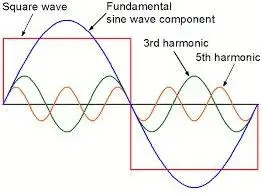In the early days of industrialization, electrical systems mostly used linear loads—devices like three-phase induction motors, resistive heaters, and incandescent lamps. These systems drew a sinusoidal current that was proportional to the applied voltage, and as a result, the overall power system remained clean and stable.
However, the landscape has significantly changed with the rise of power electronics. Today’s industrial applications rely heavily on sophisticated electronic equipment for accurate speed control, efficient power conversion, and uninterrupted power supply. While these advancements have brought immense benefits, they have also introduced a silent disruptor into the system—harmonics.
Harmonics are a growing concern in modern power systems, primarily due to the widespread use of non-linear loads. Their impact on power quality is significant, leading to equipment malfunctions, energy losses, and increased maintenance.
This article explores what harmonics are, how they impact electrical systems, and what can be done to mitigate their effects.
What Are Harmonics in a Power System?
In an ideal world, both voltage and current waveforms in an AC system should be perfectly sinusoidal. However, in real-world conditions—especially in systems with non-linear loads—the current drawn is not proportional to the applied voltage. This distortion leads to the appearance of harmonics, which are voltage or current components with frequencies that are whole-number multiples of the system’s fundamental frequency (50 Hz or 60 Hz).
For instance, in a 50 Hz system:
- 2nd harmonic = 100 Hz
- 3rd harmonic = 150 Hz
- 5th harmonic = 250 Hz, and so on.
These additional frequencies distort the original waveform and result in a polluted power signal, affecting the overall power quality.

Read detailed article on- Harmonics and Harmonic Frequency in AC Circuits
Why Harmonics Are Increasing
The rise in harmonics is closely linked to the increasing use of semiconductor-based equipment, such as:
- Variable Frequency Drives (VFDs)
- Soft starters
- Uninterruptible Power Supplies (UPS)
- SCR and IGBT-based drives
- Switching power supplies in computers
- LED lighting systems
These devices draw current in a non-linear fashion, contributing to the generation of harmonic frequencies in the power system.
How Harmonics Affect Power Quality
Harmonics degrade the quality of power in several ways. The main effects include:
1. Equipment Overheating
Harmonics increase I²R losses, especially in motors and transformers. This leads to excess heat generation, insulation breakdown, and ultimately, reduced equipment lifespan.
2. Resonance and Capacitor Damage
Harmonics can cause resonance conditions when they interact with power factor correction capacitors, leading to voltage amplification and capacitor failure.
3. Nuisance Tripping
Sensitive protection devices, such as relays and circuit breakers, may misoperate due to distorted waveforms, leading to frequent and unwanted tripping.
4. Reduced System Efficiency
With increased losses and disrupted voltage balance, the system’s overall energy efficiency drops. More energy is consumed to do less effective work.
5. Communication Errors
In digital systems, harmonics can cause electromagnetic interference (EMI), leading to data corruption, communication breakdown, and system crashes.
Read deailed Article on- Adverse Effects Of Harmonics On Electrical Equipment
Key Parameters Affected by Harmonics
Power quality isn’t defined solely by harmonic content, but harmonics influence several voltage-related parameters, such as:
- Voltage dips and swells
- Slow and fast voltage variations
- Short and long-duration interruptions
- Flicker in lighting systems
- Transient overvoltages
- Temporary overvoltages
These variations can severely affect sensitive industrial and commercial equipment.
Common Sources of Harmonics
Here are some of the most common devices and systems that introduce harmonics into the network:
| Source | Nature |
|---|---|
| Variable Frequency Drives (VFDs) | Non-linear inverter operation |
| DC Drives with SCRs/IGBTs | Phase-controlled rectification |
| UPS systems | Static switches and inverters |
| Welding machines | Pulse and arc-based operation |
| Fluorescent/LED lighting | Electronic ballasts |
| Computers, Printers, Office Devices | Switched-mode power supplies |
Real-world Effects of Harmonics
The presence of harmonics in power systems leads to several practical challenges:
| Component Affected | Effect |
|---|---|
| Transformers | Overheating, derating required |
| Motors | Increased vibrations, torque pulsations |
| Capacitor Banks | Overload, resonance issues |
| Power Cables | Extra heating, voltage drops |
| Protective Devices | False tripping |
| Meters & Relays | Measurement errors |
| IT Systems | Data loss, crashing, EMI issues |
Harmonic Mitigation Techniques
While harmonics can’t always be eliminated, their impact can be significantly reduced through mitigation strategies:
1. Passive Filters
These are tuned circuits (typically LC) that absorb specific harmonic frequencies. They are simple and cost-effective for lower-order harmonics.
2. Active Harmonic Filters
These advanced filters dynamically inject currents that cancel out harmonics in real-time. They are suitable for complex and varying load conditions.
3. 12 or 18-Pulse Converters
Using more pulses in rectifier systems reduces the amplitude of generated harmonics and minimizes Total Harmonic Distortion (THD).
4. Isolation Transformers
These separate sensitive loads from harmonic-producing sources, offering electrical decoupling and improved noise suppression.
5. Line Reactors
Installed in series with non-linear loads, line reactors help smooth out current spikes and reduce harmonic content.
6. Proper Equipment Sizing
Oversizing cables, transformers, and other power components helps handle the additional heating and stress caused by harmonics.
Conclusion
Harmonics are an unavoidable consequence of modern industrial and commercial power systems. As the use of non-linear loads continues to grow, so does the risk to power quality. From overheating of transformers to tripping of protection devices, harmonics have a cascading effect on the entire electrical infrastructure.
However, by understanding the sources and effects of harmonics—and implementing appropriate mitigation techniques—industries can maintain a clean, reliable, and efficient power supply. Investing in power quality solutions not only improves system performance but also reduces operational costs and enhances equipment longevity.
Related Articles: